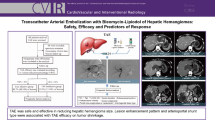Abstract
Hepatocellular adenomas (HCAs) are benign liver lesions which may be complicated by spontaneous intratumoral bleeding, with or without rupture into the abdominal cavity, or malignant degeneration. Recent advances in radiological interventional techniques now offer selective transcatheter arterial embolization (TAE) as an alternative approach to surgery as the initial treatment to stop the bleeding or as an elective treatment to reduce the tumor mass of the HCA. Herein, we report our initial experience using TAE in the management of HCA. Five female patients and one male patient presented with spontaneous hemorrhage of HCA. Four patients were initially treated with selective TAE to stop the bleeding. In two patients in whom the bleeding stopped spontaneously, TAE was electively undertaken 1 year after presentation to reduce the tumor mass of HCAs >5 cm. Selective TAE as initial treatment in patients with spontaneous bleeding of HCA with or without rupture is effective and will change the need for urgent laparotomy to control bleeding. Selective TAE may also be used as an elective treatment to reduce the tumor mass of larger HCAs.






Similar content being viewed by others
References
Little JM, Kenny J, Hollands MJ (1990) Hepatic incidentaloma: a modern problem. World J Surg 14:448–451
Rooks JB, Ory HW, Ishak KG, et al. (1979) Epidemiology of hepatocellular adenoma. The role of oral contraceptive use. JAMA 242:644–648
Shortell CK, Schwartz SI (1991) Hepatic adenoma and focal nodular hyperplasia. Surg Gynecol Obstet 173:426–431
Tao LC (1991) Oral contraceptive-associated liver cell adenoma and hepatocellular carcinoma. Cytomorphology and mechanism of malignant transformation. Cancer 68:341–347
Ault GT, Wren SM, Ralls PW, Reynolds TB, Stain SC (1996) Selective management of hepatic adenomas. Am Surg 62:825–829
Leese T, Farges O, Bismuth H (1988) Liver cell adenomas. A 12-year surgical experience from a specialist hepato-biliary unit. Ann Surg 208:558–564
Flowers BF, McBurney RP, Vera SR (1990) Ruptured hepatic adenoma. A spectrum of presentation and treatment. Am Surg 56:380–383
Huurman VA, Stoot JH, van der Linden E, Terpstra OT, Schaapherder AF (2006) Necrosis of a large hepatic tumor after hemorrhage and subsequent selective arterial embolization. World J Gastroenterol 12(37):6059–6061
Baum JK, Bookstein JJ, Holtz F, Klein EW (1973) Possible association between benign hepatomas and oral contraceptives. Lancet 2:926–929
Soe KL, Soe M, Gluud C (1992) Liver pathology associated with the use of anabolic-androgenic steroids. Liver 12:73–79
Belghiti J, Pateron D, Panis Y, et al. (1993) Resection of presumed benign liver tumours. Br J Surg 80:380–383
Rubin RA, Mitchell DG (1996) Evaluation of the solid hepatic mass. Med Clin North Am 80:907–928
Vergara V, Muratore A, Bouzari H, et al. (2000) Spontaneous rupture of hepatocelluar carcinoma: surgical resection and long-term survival. Eur J Surg Oncol 26:770–772
Rahili A, Cai J, Trastour C, et al. (2005) Spontaneous rupture and hemorrhage of hepatic focal nodular hyperplasia in lobus caudatus. J Hepatobil Pancreat Surg 12:138–142
Corigliano N, Mercantini P, Amodio PM, et al. (2003) Hemoperitoneum from a spontaneous rupture of a giant hemangioma of the liver: report of a case. Surg Today 33:459–463
Murakami R, Taniai N, Kumazaki T, Kobayashi Y, Ogura J, Ichikawa T (2000) Rupture of a hepatic metastasis from renal cell carcinoma. Clin Imaging 24:72–74
Grazioli L, Federle MP, Brancatelli G, Ichikawa T, Olivetti L, Blachar A (2001) Hepatic adenomas: imaging and pathologic findings. Radiographics 21:877–892
Casillas VJ, Amendola MA, Gascue A, Pinnar N, Levi JU, Perez JM (2000) Imaging of nontraumatic hemorrhagic hepatic lesions. Radiographics 20:367–378
Marini P, Vilgrain V, Belghiti J (2002) Management of spontaneous rupture of liver tumours. Dig Surg 19:109–113
Erdogan D, Busch OR, van Delden OM, Ten Kate FJ, Gouma DJ, van Gulik TM (2006) Management of spontaneous haemorrhage and rupture of hepatocellular adenomas. A single centre experience. Liver Int 26:433–438
Lai EC, Wu KM, Choi TK, Fan ST, Wong J (1989) Spontaneous ruptured hepatocellular carcinoma. An appraisal of surgical treatment. Ann Surg 210:24–28
Hagiwara A, Murata A, Matsuda T, Matsuda H, Shimazaki S (2002) The efficacy and limitations of transarterial embolization for severe hepatic injury. J Trauma 52:1091–1096
Liu CL, Fan ST, Lo CM, et al. (2001) Management of spontaneous rupture of hepatocellular carcinoma: single-center experience. J Clin Oncol 19:3725–3732
Murakami R, Taniai N, Kumazaki T, Kobayashi Y, Ogura J, Ichikawa T (2000) Rupture of a hepatic metastasis from renal cell carcinoma. Clin Imaging 24:72–74
Ngan H, Tso WK, Lai CL, Fan ST (1998) The role of hepatic arterial embolization in the treatment of spontaneous rupture of hepatocellular carcinoma. Clin Radiol 53:338–341
Castells L, Moreiras M, Quiroga S, et al. (2001) Hemoperitoneum as a first manifestation of hepatocellular carcinoma in western patients with liver cirrhosis: effectiveness of emergency treatment with transcatheter arterial embolization. Dig Dis Sci 46:555–562
Kawakatsu M, Vilgrain V, Erlinger S, Nahum H (1997) Disappearance of liver cell adenoma: CT and MR imaging. Abdom Imaging 22:274–276
Wheeler PG, Melia W, Dubbins P, et al. (1979) Non-operative arterial embolisation in primary liver tumours. Br Med J 2:242–244
Author information
Authors and Affiliations
Corresponding author
Rights and permissions
About this article
Cite this article
Erdogan, D., van Delden, O.M., Busch, O.R.C. et al. Selective Transcatheter Arterial Embolization for Treatment of Bleeding Complications or Reduction of Tumor Mass of Hepatocellular Adenomas. Cardiovasc Intervent Radiol 30, 1252–1258 (2007). https://doi.org/10.1007/s00270-007-9108-4
Published:
Issue Date:
DOI: https://doi.org/10.1007/s00270-007-9108-4




